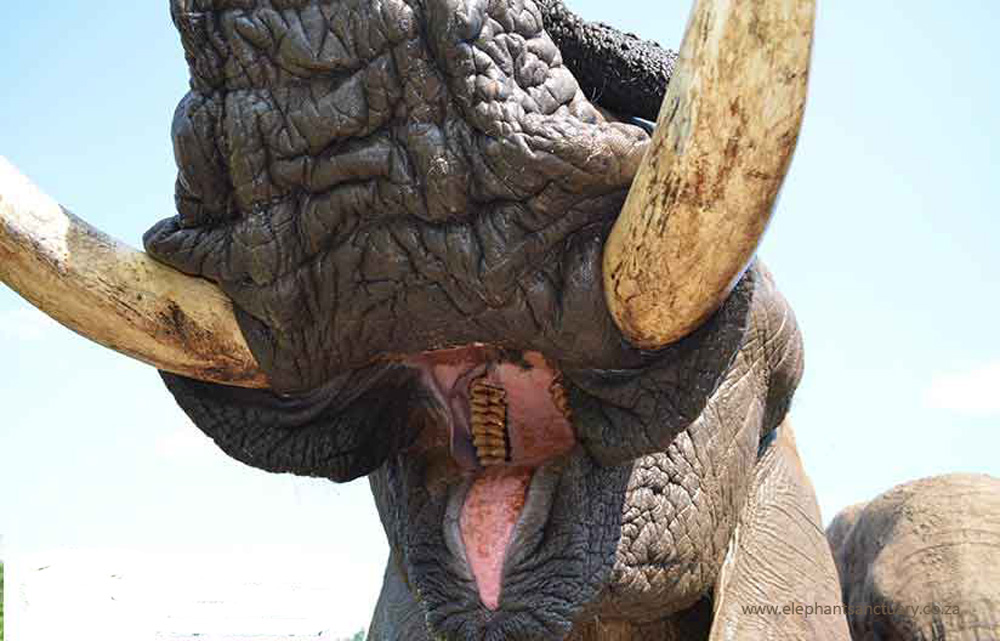African Elephant Facts in a nutshell
African Elephants are the largest land animals on earth. Slightly larger than their Asian family member their most obvious identification difference is their larger ears that look somewhat like the continent of Africa. Asian elephants have smaller, rounded ears.
Trunks and tusks
An elephant's trunk is actually a long nose used for smelling, breathing, trumpeting, drinking, and also for grabbing things—especially a potential meal. The trunk alone contains an estimated 100,000 different muscles (compared to the 640muscles in the human body!). The boneless proboscis is strong enough to kill a lion, but gentle enough to caress a baby elephant. African elephants have two finger-like members on the end of their trunks for picking up delicate objects. (Asian elephants have one.)
Both male and female African elephants have tusks they use to dig for food and water and strip bark from trees. Males use the tusks to battle one another, but the ivory has attracted violence of a far more dangerous sort.
Because ivory is so valuable to some humans, many elephants have been killed for their tusks. This trade is illegal today, but it has not been completely eliminated, and some African elephant populations remain endangered.

Teeth
The elephant’s tusks are extremely elongated, continuously growing upper incisors (similar to a human’s front teeth), used for digging, tearing and fighting. Often, an elephant will use one tusk a lot more than the other - just like a left or right-handed person.
Elephants have a total of 24 molar teeth during their lifetime, which grows from the back of the jaw and then slowly moves forward as the teeth in front wear and break down. An elephant’s life is limited by its teeth because once the last molar has worn out it will be unable to chew its food properly and die of starvation.
Young elephants can go through a set of baby teeth, but theirs include baby tusks. They fall out after about a year and are replaced with a permanent set that can grow 6 feet ( 1.8m) long and weigh about 50 pounds ( 22.7kg)

Ears
Their huge ears, which are about one-sixth of the size of their entire bodies regulate body temperature. The ears cool down warm blood by filtering it through the network of tiny blood vessels found in the wide, thin surface area of the outer ear tissue. Cooler blood then circulates to the rest of the body.
Ears are also used for signalling. When an elephant feels threatened, it will spread its ears out to the side of its head, increasing its frontal area and creating a large and pretty intimidating-looking creature.
An African elephants’ ears radiate heat to help keep these large animals cool, but sometimes the African heat is too much. Being fond of water then comes in handy! Elephants enjoy showering by sucking water into their trunks and spraying it all over themselves. Afterwards, they often spray their skin with a protective coating of dust.

Skin
African elephants’ skin is extremely sensitive. They will protect themselves from the sun and pests by wallowing in mud or flinging sand over their bodies, which will change their apparent colour from greyish black to the colour of the soil around them.
Elephants have created their very own sunscreen! After a river or swamp bath, they’ll throw mud and sand up and over themselves to protect their skin from the hot, burning sun. Clever!
Skull
Like bird bones, the elephant’s skull has lots of tiny air pockets (a honeycomb of air cavities inside the bones ) to keep it light (this is relative ! The average skull of an adult elephant weighs around 52 kilograms) this, plus particularly large neck muscles, allows them to eat and drink without struggling with an extremely heavy head. Elephants hear low frequencies (infrasounds) transmitted through the ground and conducted to their skull and inner ears through the bones of their front legs. These sounds are amplified by resonating in these inner bone chambers.

Feet & Legs
Because of the way their feet are formed, African elephants essentially walk on tiptoe. Their body weight is evenly distributed across the fatty connective tissue at the heel. Elephant feet have large fat pads – equivalent to the human heel – that fill the shape behind the toes. This tissue acts as a ‘shock absorber’ and allows the elephant to move silently.
The grooves on an elephant’s foot help the elephant grip the ground to prevent slipping and falling. During wetter seasons the grooves will become more pronounced to allow for better grip. In the dyer months, the foot becomes smoother as less grip is required.
Although they can walk and swim, elephants are one of the few mammals that can’t jump. Their legs are too slender to propel their enormous weight upward. Plus, elephants have no spring in their legs since they stand on their toes.

Pregnancy
Elephants have the longest pregnancy over any other mammal – an astonishing 22 months (more than double that of a human, which is usually nine months). Baby elephants weigh up to 200 pounds at birth.

Diet
Elephants eat roots, grasses, fruit, and bark, and they eat a lot of these things. To sustain its massive size, an adult elephant has to consume an enormous amount to food. Up to 50 gallons (189 L of water) and about 220 pounds ( 100kg) food, or approximately 70 000 calories every day.
All that eating means one thing-an awful lot of poo! Each elephant creates about one tonne of poo per week, which keeps the soil fertile and disperses tree seeds. Elephants also dig waterholes and create footpaths, literally changing the landscape around them!
Herds and habitat
Female elephants (cows) live in family herds with their young, but adult males (bulls) tend to roam on their own.
Having a baby elephant is a serious commitment. Elephants have a longer pregnancy than any other mammal—almost 22 months. Cows usually give birth to one calf every two to four years. At birth, elephants already weigh some 200 pounds (90 kilograms) and stand about 3 feet tall.
Source :
- Wikipedia
- Independent




